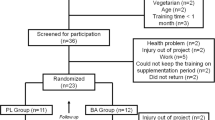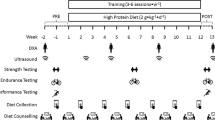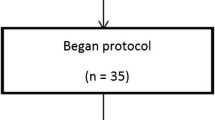Abstract
Carnosine (Carn) occurs in high concentrations in skeletal muscle is a potent physico-chemical buffer of H+ over the physiological range. Recent research has demonstrated that 6.4 g.day−1 of β-alanine (β-ala) can significantly increase skeletal muscle Carn concentrations (M-[Carn]) whilst the resultant change in buffering capacity has been shown to be paralleled by significant improvements in anaerobic and aerobic measures of exercise performance. Muscle carnosine increase has also been linked to increased work done during resistance training. Prior research has suggested that strength training may also increase M-[Carn] although this is disputed by other studies. The aim of this investigation is to assess the effect of 10 weeks resistance training on M-[Carn], and, secondly, to investigate if increased M-[Carn] brought about through β-ala supplementation had a positive effect on training responses. Twenty-six Vietnamese sports science students completed the study. The subjects completed a 10-week resistance-training program whilst consuming 6.4 g.day−1 of β-ala (β-ALG) or a matched dose of a placebo (PLG). Subjects were assessed prior to and after training for whole body strength, isokinetic force production, muscular endurance, body composition. β-Alanine supplemented subjects increased M-[Carn] by 12.81 ± 7.97 mmol.kg−1 dry muscle whilst there was no change in PLG subjects. There was no significant effect of β-ala supplementation on any of the exercise parameters measured, mass or % body fat. In conclusion, 10 weeks of resistance training alone did not change M-[Carn].


Similar content being viewed by others
References
Ahlborg B, Bergrström J, Ekelund LG, Guarineri G, Harris RC, Hultman E, Nordesjö LO (1972) Muscle metabolism during isometric exercise performed at constant force. J Appl Physiol 33:224–228
Batrukova MA, Rubtsov AM (1997) Histidine-containing dipeptides as endogenous regulators of the activity of sarcomplasmic Ca-release channels. Biochim Biophys Acta 21:142–150
Bergström J (1962) Muscle electrolytes in man. Determination by neutron activation analysis on needle biopsy specimens. A study on normal subjects, kidney patients and patients with chronic diarrhoea. Scand J Clin Lab Invest 14:100–110
Boldyrev AA, Dupin AM, Pindel EV, Severin SE (1988) Antioxidative properties of histidine-containing diepeptides from skeletal muscles of vertebrates. Comp Biochem Physiol 89:245–250
Dukta TL, Lamb GD (2004) Effects of carnosine on excitation–contraction coupling in mechanically-skinned rat skeletal muscle. J Muscle Res Cell Motil 25:203–213
Dunnett M, Harris RC (1997) High-performance liquid chromatographic determination of imidazole dipeptides, histidine, 1-methylhistidine and 3-methylhistadine in equine and camel muscle and individual muscle fibres. J Chromatogr B 688:47–55
Durin JV, Wormsley J (1974) Body fat assessment from total body density and its estimation form skinfold thickness: measurements on 481 men and women from ages 17–72. Br J Nutr 32:77–97
Edge J, Hill-Haas S, Goodman C, Bishop D (2006) Effects of resistance training on H+ regulation, buffer capacity, and repeated sprints. Med Sci Sports Exerc 38:2004–2011
Fritzon P (1957) The catabolism of C14-labeled uracil, dihydro-uracil and β-ureidopropioninc acid in rat liver slices. J Biol Chem 226:223–228
Harris RC, Hultman E, Nordejö LO (1974) Glycogen, glycolytic intermediates and high-energy phosphates determined in biopsy samples of musculos quadriceps femoris of man at rest. Methods and variance of values. Scand J Clin Lab Invest 33:109–120
Harris RC, Marlin DJ, Dunnett M, Snow DH, Hultman E (1990) Muscle buffering capacity and dipeptide content in the thoroughbred horse, greyhound dog and man. Comp Biochem Physiol 97A:249-251
Harris RC, Dunnett M, Greenhaff PL (1998) Carnosine and taurine contents in individual fibres of human vastus alteralis muscle. J Sports Sci 16:639–643
Harris RC, Tallon MJ, Dunnett M, Boobis LH, Coakley J, Kim HJ, Fallowfield JL, Chester CA, Sale C, Wise JA (2006) The absorption of orally supplied β-alanine and its effect on muscle carnosine synthesis in human vastus lateralis. Amino Acids 30:279–289
Harris RC, Kim HJ, Kim CK, Lee YW, Sale C, Harris DB, Wise JA (2007) The effect of a supplement containing β-alanine on muscle carnosine synthesis and exercise capacity, during 12 weeks of combined endurance and weight training. J Sport Sci 25:336–337
Hill CC, Harris RC, Kim HJ, Harris BD, Sale C, Boobis LH, Kim CK, Wise JA (2007) Influence of β-alanine supplementation on skeletal muscle carnosine concentrations and high intensity cycling capacity. Amino Acids 32:225–233
Hoffman J, Ratamess N, Kang J, Mangine G, Faigenbaum A, Stout J (2006) Effects of creatine and β-alanine supplementation on performance and endocrine responses in strength/power athletes. Int J Sport Nutr Exerc Metab 16:430–446
Kim JH, Kim CJ, Changkeun K, Harris RC, Harris DB, Sale C, Wise JA (2006) Effect on muscle fibre morphology and carnosine content after 12 days training of korean speed skaters. Med Sci Sports Exerc 37:S-192
Mannion AF, Jakeman PM, Willan PL (1994) Effects of isokinetic training of the knee extensors on high-intensity exercise performance and skeletal muscle buffering. Eur J Appl Physiol Occup Physiol 68:356–361
Martin R, Edcall JT (1960) The association of divalent cations with acylacted histidine derivatives. J Am Chem Soc 82:1107
Ponte J, Harris RC, Hill CA, Sale C, Jones GA, Kim HJ, Wise JA (2007) Effect of 14–28 days of β-alanine supplementation on isometric endurance of the knee extensors. J Sport Sci 25:334
Schott J, McCully K, Rutherford OM (1995) The role of metabolites in strength training. II. Short versus long isometric contractions. Eur J Appl Physiol Occup Physiol 71:337–341
Stout JR, Cramer JT, Zoeller RF, Torok D, Costa P, Hoffman JR, Harris RC, O’Kroy J (2007) Effects of β-alanine supplementation on the onset of neuromuscular fatigue and ventilatory thresholds in women. Amino Acids 32:381–386
Suzuki Y, Ito O, Takahashi H, Takahashi K (2004) Effect of carnosine and anserine supplementation on skeletal muscle carnosine concentration in humans. Intl J Sport Health Sci 2:105–110
Tallon MJ, Harris RC, Boobis LH, Fallowfield JL, Wise JA (2005) The carnsoine content of vastus lateralis is elevated in resistance-trained bodybuilders. J Strength Cond Res 19:725–729
Author information
Authors and Affiliations
Corresponding author
Rights and permissions
About this article
Cite this article
Kendrick, I.P., Harris, R.C., Kim, H.J. et al. The effects of 10 weeks of resistance training combined with β-alanine supplementation on whole body strength, force production, muscular endurance and body composition. Amino Acids 34, 547–554 (2008). https://doi.org/10.1007/s00726-007-0008-3
Received:
Accepted:
Published:
Issue Date:
DOI: https://doi.org/10.1007/s00726-007-0008-3




